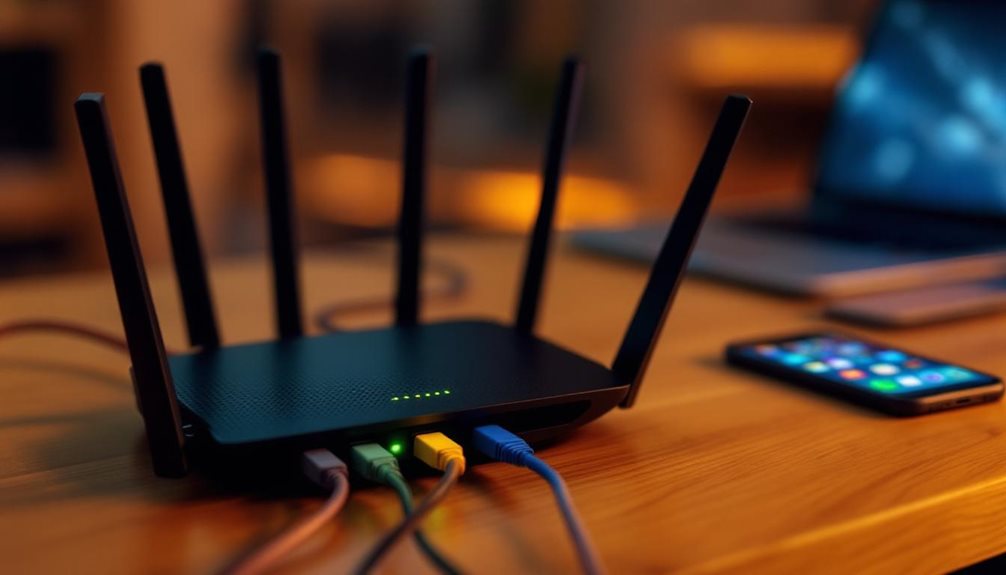Setting up a VPN at home enhances online security and privacy. First, assess your router for VPN compatibility and consider a firmware upgrade if needed. Next, generate digital certificates and configure firewall settings to allow VPN traffic.
After setting up the server, test your connection to confirm there are no leaks and verify that your IP address is masked. If problems occur, check configurations and firewall settings. There’s more to learn about optimising your VPN experience.
Understanding VPN Technology and Its Benefits
When considering the importance of online security, grasping VPN technology reveals its numerous benefits. A Virtual Private Network (VPN) creates secure tunnels using protocols like IPsec or SSL/TLS, which encapsulate and encrypt data. This encryption is essential for protecting sensitive information from unauthorised access. VPNs enable network hosts to exchange messages transparently across another network whilst protecting user privacy when communicating over untrusted networks controlled by third parties.
VPNs also extend private networks, allowing remote access to office resources over insecure connections. Furthermore, they assign virtual IP addresses, helping users maintain anonymity whilst online. Various implementation models, such as Remote Access and Mobile VPNs, cater to different needs. Additionally, VPNs ensure secure internet access for users, safeguarding sensitive information and acting as a shield against cyber threats. For optimal VPN performance, users should ensure they have stable uncapped broadband as the foundation for reliable encrypted connections.
For South African users, VPN technology is particularly valuable given concerns about data protection under POPIA legislation and the need to securely access international content. VPNs support seamless operations by providing uninterrupted access and reducing the risk of data breaches that could compromise business continuity.
Ultimately, VPN technology not only improves security but also promotes privacy by preventing tracking and ensuring safe browsing, especially on public Wi-Fi networks commonly found in shopping centres, airports, and coffee shops across South Africa. It’s an important tool in today’s interconnected online environment.
Preparing Your Network for VPN Setup
Preparing a network for VPN setup can seem challenging, but it doesn’t have to be. First, assess your router’s compatibility. Check if it supports built-in VPN features or consider models like the ASUS RT-AX88U Pro, which are readily available through South African retailers like Takealot and Incredible Connection.
Upgrading with third-party firmware like DD-WRT can reveal additional capabilities. Next, evaluate your network infrastructure. Confirm your upload and download speeds meet VPN demands and that VPN passthrough is enabled. Consider that uncapped broadband solutions can eliminate data concerns when running VPN connections continuously. It’s also important to consider that setting up a VPN can be done on individual devices or directly on the router for network-wide protection. Additionally, be aware that upload bandwidth is crucial for ensuring your VPN performs well, especially when accessing remote resources.
It’s also wise to audit devices for any potential conflicts. Security precautions are vital; disable unnecessary protocols, enable firewalls, and enforce strong authentication.
Finally, back up your router’s current settings before making any firmware changes. With these steps, the path to a successful VPN setup becomes clearer and more manageable.
Step-by-Step Guide to Configuring Your VPN
Configuring a VPN can feel like piecing together a puzzle, but with a clear step-by-step guide, it becomes much easier to navigate.
First, generate digital certificates and private keys using tools like Easy-RSA for OpenVPN.
Next, configure firewall settings to permit VPN traffic, ensuring secure routing. This is crucial because strong encryption helps protect your data from unauthorised access during transmission.
Edit your server configuration files to define the protocol and port.
Don’t forget to enable IP forwarding to allow the server to act as a gateway.
After that, start the OpenVPN service to manage encryption.
Finally, choose a protocol that suits your requirements, balancing speed and security.
With these steps, South African users can successfully set up a VPN that protects their online privacy and data whilst complying with local data protection regulations.
Testing and Troubleshooting Your VPN Connection
Testing and troubleshooting a VPN connection can feel like traversing a maze, but it doesn’t have to be intimidating. Start with basic leak tests. For example, employ DNSLeakTest.com to confirm no DNS leaks are present.
Comparing your IP address before and after connecting with WhatIsMyIP.com can validate if your VPN is masking your identity. Next, check for WebRTC and IPv6 leaks using BrowserLeaks.com and test-ipv6.com.
Advanced tools like `ping` and `traceroute` can diagnose connectivity issues, whilst monitoring the VPN app’s status ensures stability.
Finally, perform reconnection tests to verify the effectiveness of the Kill Switch feature. By systematically addressing these areas, users can effectively troubleshoot and improve their VPN experience without unnecessary stress.
